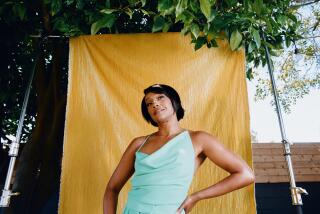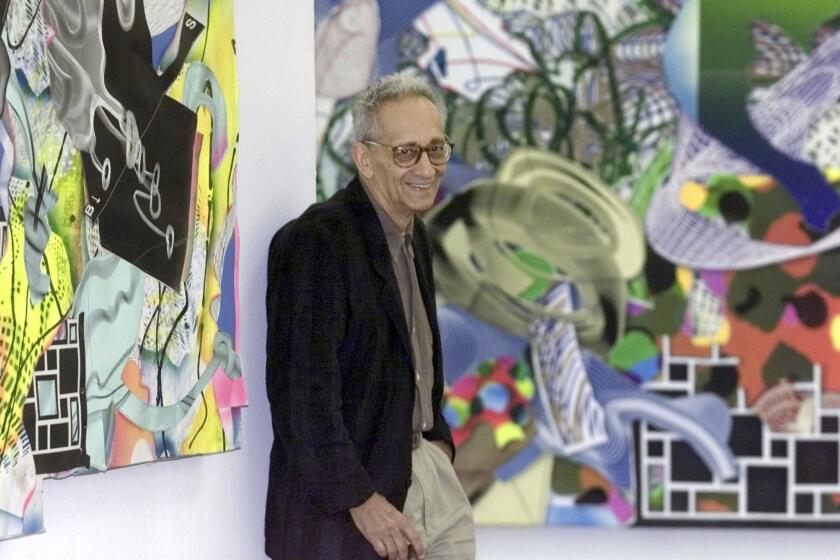Marching to Beep of Her Own Drum
Think percussion, but don’t think primitive. Drumming, like so much else, has gone digital.
“I’m so excited by everything that is possible now,” Amy Knoles says. “I can hit one note on a MIDI mallet instrument and trigger all kinds of sounds and events which I can play against. The interactive stuff is the most interesting to me.”
A casual glance around her studio--a holdover from the loft boomlet in the downtown warehouse district--reveals MIDI instruments alongside traditional acoustic marimbas and drum kits, racks of samplers and synthesizer modules, recording gear and computers, monitors and amps, and the inevitable concomitant of a modern career, a fax machine.
Although Knoles has a solid background in acoustic percussion, and a diversified resume that includes touring and recording with pop acts ranging from Vikki Carr to Toni Childs and Luther Vandross to David & David, her most characteristic work now is in new music--as a solo act, with bassist Robert Black in the duo Basso Bongo, and with the California E.A.R. Unit, an ensemble that she helped found as a student at CalArts.
Basso Bongo presented one of the prestigious Monday Evening Concerts at the Los Angeles County Museum of Art in March. Wednesday the E.A.R. Unit--the initials don’t stand for anything in particular, Knoles confirms--ends its seventh year as ensemble-in-residence at the museum with a program listing John Cage’s “Music for Seven” and works by David Lang, Scott Lindroth, Charles Wood and Douglas Cohen.
New equipment is both bane and blessing for Knoles, an unabashed techno-junkie. The learning curve on the latest generation hardware and software is as steep as the price, and you can hear the weary voice of experience when she intones what might be Knoles Law: “Things only go bad in performance; they don’t go bad in rehearsal.”
Case in point: that Basso Bongo concert in March, where the unexpected silence of her amplified battery caused an equipment crawl, flicking switches and testing connections. The solution: a new cable, replacing one that had always worked fine up to that point.
“What you have to do is keep your cool, and figure out what is wrong through a process of elimination,” Knoles says. “I’ve gotten pretty good at trouble-shooting.
“Actually, I’m fairly proud of how well it all works. You have people like Morton Subotnick and Todd Machover and they work and work on just one system. With Basso Bongo, we have eight or nine pieces from different composers, all with different system requirements.”
Knoles gets another encounter with the difficult electro-acoustic music of Subotnick next week, when the E.A.R. Unit presents two concerts May 27 and 28 at the Santa Monica Museum of Art honoring the pioneering composer’s 60th birthday.
“It’s the first time we’ve ever tried to present ourselves, but nobody was doing anything for Mort’s 60th birthday,” Knoles explains. “It’s frightening, there’s a lot involved, from the music to setting up chairs. But it’s really fun, exciting music so the energy is always there.”
Her first solo recording, however, of Julio Martin Viera’s Divertimento III, just made in San Diego, is acoustic.
“That was kind of unusual, because most of my solo stuff is all electronic now,” Knoles says. “This was a big set-up, so huge that every lick had to be memorized. I wanted to kill him.”
So why percussion in the first place?
“Quaker oatmeal boxes, I don’t know! I’ve played percussion since third grade. I’ve always wanted to do it, and never thought of not doing it. My folks were very supportive. I got a new drum every year. By high school I had the biggest drum set around.”
Knoles has been collaborating with performance artist doyenne Rachel Rosenthal, and next season has a five-week project with her at SUNY Stony Brook. Basso Bongo will be going to Eastern Europe, and the E.A.R. Unit workload includes its part in the initial season of Music in Motion.
Developed by Joe Franklin with grants from the Pew Trust and the Lila Wallace-Reader’s Digest Fund, Music in Motion has brought five ensembles together with five presenters in a unique commissioning project. The E.A.R. Unit and Arizona State University West have asked Bernardo Feldman and Eve Beglarian for new pieces, which will be created with the ensemble and audience interaction in public workshops prior to the concert.
All this means incessant practicing, of course, as well as running a hyperactive cottage industry, with the odd studio gig and struggles to wrest all the potential from new equipment and software thrown in. Earlier this year, Knoles was in Alaska for five weeks, performing music by John Luther Adams. She spent the days drumming, the nights cross-country skiing under the aurora borealis, and was up at 5 a.m. on a pay phone, trying to book the E.A.R. Unit’s East Coast tour.
“It’s insane,” Knoles sighs. “Maybe when I get older I’ll stop. I think I’ll do a six-week residency in Sao Paulo (a product of her recording with Martin Viera), but that is as settled as I’ll get soon.
“I enjoy working with composers on notation and new techniques,” Knoles says. “It feels as important to me as being a surgeon or something, because we’re taking history further. I think it’s really important for someone to do it with love, however corny that sounds.
“It’s sort of like taking a vow of poverty, playing new music--although I’m not complaining about my fees. You have to be really dedicated to stick with this, because it’s not a big money-maker at this point.”
More to Read
The biggest entertainment stories
Get our big stories about Hollywood, film, television, music, arts, culture and more right in your inbox as soon as they publish.
You may occasionally receive promotional content from the Los Angeles Times.






